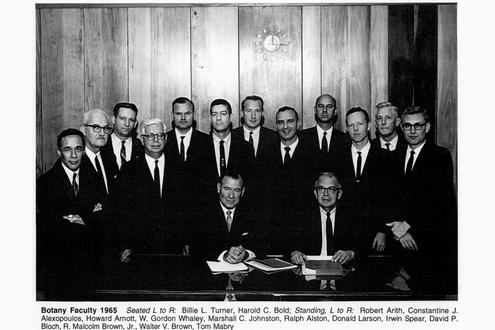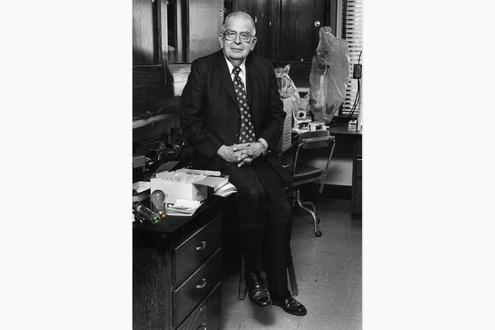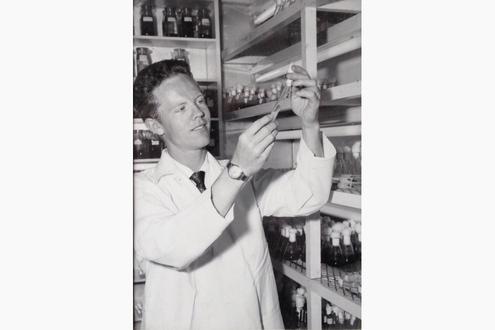The Plant Research Institute Endowment

In 1949, Professor W. Gordon Whaley became chairman of the first Department of Botany at UT. He led the department until 1962, by which time it had earned national distinction. Professor Harold C. Bold was Chairman from 1962 to1968. As chairmen, Whaley and Bold recruited many well-known plant scientists to the department. These included Constantine J. Alexopoulos, Tom Mabry, Ralph Austin, and Billie L. Turner. The Department of Botany flourished in this decade as new scientific tools became available. Professor Whaley organized the Cell Research Institute in 1948 and was its director until 1979, bringing to it a new transmission electron microscope. Whaley’s work with maize and an organelle known as the Golgi apparatus led the research of the day. In fact, much of the earlier understanding of the function of the Golgi apparatus, a cell organelle found in all plant and animal eukaryotic cells, came from research on the Golgi apparatus of maize. Malcolm Brown entered UT Austin as a freshman in 1957. Harold Bold came to UT that same year. At the time Malcolm was a pre-med major. His father, R. Malcolm Brown, M.D., of Pampa, Texas, wanted his eldest son to become a doctor and Malcolm Jr. dutifully enrolled in the UT pre-med program. Malcolm’s first course at the University was freshman biology taught by Dr. Walter V. Brown, a plant scientist. Malcolm had always loved plants, developing the knowhow from observing his mother, Clementine, while he was growing up in Pampa. During his junior year in 1959 he took a course in plant morphology taught by Professor Harold C. Bold.

Professor Harold C. Bold in his office at The University of Texas circa 1962.
During the course, Dr. Bold announced that he needed someone to wash dishes in his laboratory and Malcolm volunteered for the job since he needed some ready cash. Dr. Bold was pleased at Malcolm’s rapid assimilation of things algal, so he urged Malcolm to take the summer Marine Botany Course at Woods Hole, Massachusetts, in 1959. This was a graduate course featuring algae. Dr. Bold enrolled Malcolm as the only undergraduate in the class. Malcolm returned to Austin enthusiastic about algae and botany in general. It was the end of pre-med for Malcolm and the beginning of his long relationship with botany. He graduated from UT Austin in 1961 with a BA in botany.

Photo of Malcolm demonstrating a culture tube of green algae for the brochure, “Careers in Botany” for the Botanical Society of America. The photo was made in 1960.
Dr. Bold asked Malcolm to stay on as a graduate student, and in 1964 he completed his PhD. In those days it was highly unusual to invite a graduate of UT to join the faculty. He became a tenure track faculty member in 1965 when he took the position of assistant professor of botany. Malcolm remained at UT until he was recruited to join the Department of Botany at the University of North Carolina in Chapel Hill in 1969. Then in 1981 Malcolm was invited to return to his alma mater as the first holder of the Johnson & Johnson Centennial Chair in Plant Cell Biology. The compelling reason for Malcolm to return to Texas was that during those years in Chapel Hill he saw the growth of the Department of Botany at UT Austin, which was to continue to be considered the top department in the United States for many years. Malcolm’s wife, Ann, grew up in Austin and her parents lived there, which was another deciding factor.
In 1999 the administration decided to create the School of Biological Sciences and fuse botany and zoology into biology, marking the loss of the No.1-ranked Department of Botany in the United States. While its former faculty members joined other biological science departments, the status of plant science on the UT campus had never been quite the same. Thus, in an effort to upgrade plant sciences and to take advantage of the excellent resources in plant sciences on the UT campus, the plant science faculty unanimously approved the proposal for an endowment to be established by The University of Texas System Board of Regents in 2011. Malcolm sincerely believes that the plant sciences are critically important to biology and science in general. To create a sustainable future for humankind, knowledge of the structure and function of plants is critical.
The University of Texas has a remarkable history of promoting the plant sciences. Thanks to the Plant Research Institute Endowment and the funding it generates to hire and support faculty and students, plant science at The University of Texas at Austin will once again have a world-class reputation.
How to Give
Learn more at giving.utexas.edu
Search Endowments
Look for inspiring stories
